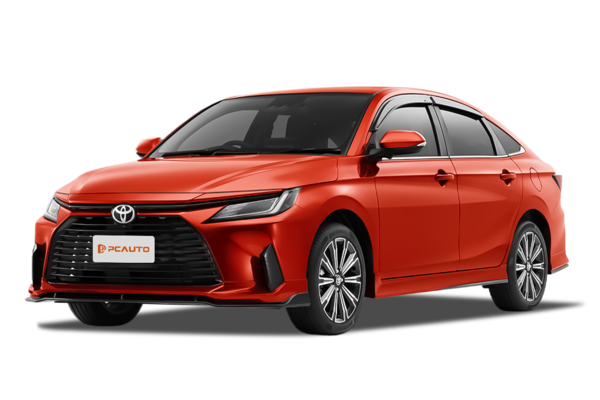Q
how to clean toyota vios aircon filter
To clean the air conditioning filter of a Toyota Vios, first turn off the car engine and air conditioning system. Then locate the air conditioning filter, which is usually located behind the glove box. Carefully open the glove box and remove the parts holding the filter. Take out the filter and gently blow away surface dust and debris with compressed air. If the filter is severely dirty, gently clean it with mild soapy water and rinse and dry it thoroughly. Once the filter is completely dry, it can be reinstalled in the reverse order of the steps.
Special Disclaimer: This content is published by users and does not represent the views or position of PCauto.
Related Q&A
Q
How to change time on the car dashboard in Toyota Vios?
To change the time on the dashboard of a Toyota Vios car, you can usually do it like this: First, find the settings button on the dashboard, which may be labeled "SET" or similar. After pressing it, select the time setting option through the control buttons on the steering wheel or the adjustment lever next to the dashboard. Then adjust the hours and minutes in sequence as prompted. Different years and configurations of Toyota Vios may have slight differences in operation details, but the general steps are the same.
Q
How to open the front hood of Toyota Vios?
To open the hood of a Toyota Vios, you usually need to first find the hood release lever inside the cab, which is generally located on the left side of the driver's foot area. After pulling the lever, you will hear the sound of the hood popping up. At this point, walk to the front of the vehicle, at the center of the front end of the hood, reach in and feel for a toggle switch, move it to the left and lift the hood at the same time.
Q
How to unlock the steering wheel of Toyota Vios?
To unlock the steering wheel of a Toyota Vios, typically you can try gently turning the wheel while simultaneously pressing the ignition switch. If this method does not work, it may be a problem with the vehicle's anti-theft system. In this case, it is advisable to contact Toyota's official after-sales service, as they have professional tools and techniques to resolve this issue.
Q
How to replace the battery of car key in Toyota Vios?
To replace the battery in a Toyota Vios car key, you first need to prepare a new suitable battery, typically a CR2032 model. Find the gap on the key and use a small tool to gently pry open the key case. Remove the old battery, noting the direction of the positive and negative poles, and then insert the new battery in the correct direction, finally closing the key case. Be careful when operating to avoid damaging the key components.
Q
How to lock Toyota Vios?
The locking method of Toyota Vios is usually as follows: use the lock button on the remote key, press it to lock the car; some models are also equipped with a keyless entry system, the car will automatically lock after leaving a certain distance. In addition, you can also lock the car by inserting the mechanical key into the door lock core. Please make sure to ensure that no valuables are left in the vehicle and that the windows are completely closed.
Q
How to unlock the back seat of Toyota Vios?
The usual way to unlock the rear seat in a Toyota Vios is to locate the unlock device at the top of the rear seat and pull directly. However, it should be noted that Vios of different years may have slight differences in details.
Q
What is the benefit of having acoustic windshield for Toyota Vios?
The benefit of acoustic windshield for the Toyota Vios is that it can significantly reduce wind noise during driving, providing a quieter and more comfortable environment inside the car. This helps to reduce fatigue for the driver and passengers, improving the driving experience. At the same time, a quieter interior environment also makes communication inside the car easier and clearer, without being disturbed by external noise. In addition, it can also enhance the overall sound insulation effect of the vehicle to some extent, enhancing the sense of quality of the vehicle.
Q
What is the capacity of fuel tank in Toyota Vios?
The fuel tank capacity of the Toyota Vios in Malaysia is typically about 42 liters. However, the specific fuel tank capacity may vary slightly depending on the configuration and production year of the model.
Q
How many cylinders in Toyota Vios?
The Toyota Vios usually comes equipped with a 4 cylinder engine. This configuration is quite common in the Malaysian market, providing a smooth power output and good fuel economy, meeting the daily travel needs of local consumers.
Q
How much is Toyota Vios 2024?
The price of the Toyota Vios 2024 in Malaysia can vary due to factors such as configuration and region. Generally speaking, the price of its basic configuration is roughly about RM 89,600, and the price of the high-end version is around RM 95,500.
Latest Q&A
Q
What Is the Brand of Honda Civic's Tire?
The original - equipped tire brands adopted by the Honda Civic vary depending on different model years, vehicle types, and regional dealerships. Commonly, they include Michelin (such as Primacy 4 or Pilot Sport 4), Yokohama (like Advan dB or BluEarth - GT), and Bridgestone (Turanza T005A). These tires are characterized by their quietness, wear resistance, and wet - grip performance, which align with Honda's positioning for the Civic's well - balanced performance.
For example, the high - end 1.5 TC - P model might come with the higher - performance Michelin Pilot Sport series, while the entry - level 1.8S could be paired with more economy - oriented Yokohama tires. It's recommended that owners check the markings on the tire sidewall to confirm the specific model (e.g., 215/50 R17).
In addition, vehicles from different batches may have their tire brands changed due to supply - chain adjustments. If owners have higher requirements for the performance of the original tires, they can consult the authorized service center during maintenance or upgrade the tires on their own (such as choosing Continental or Goodyear). However, it's important to note that the tire size and load index must match the original specifications (most FK5 - generation models use 215/50 R17 or 235/40 R18) to ensure driving safety and maintain warranty rights.
Q
Is Honda Civic Equipped with Apple Carplay?
The currently available 11th-generation Honda Civic (Honda Civic 2023 FK) comes standard with Apple CarPlay wireless connectivity across the whole range (wired connection may also be retained in some models). Paired with a 9 - inch high - definition touchscreen, it seamlessly integrates navigation, music, and call operations for iPhone users.
As for the previous 10th - generation Civic (FC models), the mid - cycle facelift versions after 2019 (some 1.5 TC/TC - P models) also started to introduce Apple CarPlay. However, it should be noted that the early FC versions from 2016 - 2018 only support the Honda original system. If you want CarPlay, you may need to install a third - party module by yourself.
It is recommended that before buying a car, you confirm whether the function is available through the "Smartphone Connection" icon in the upper - right corner of the in - car screen or check the voice command button (with a microphone icon) on the steering wheel. If you're buying a used car, you can ask to test the compatibility by connecting your phone.
In addition, Honda Malaysia has been actively upgrading the in - car system in recent years. The new - generation Civic supports wireless Android Auto and maintains stable compatibility with the iOS system (it is recommended to use iOS 14 or later). In the future, system updates may further optimize the connection stability and response speed.
Q
What Is the Pitch Circle Diameter of Honda Civic?
PCD (Pitch Circle Diameter) refers to the diameter of the central circle of the bolt holes in an automobile wheel hub. The PCD sizes of Honda Civic vary across different years and versions. Although the PCD dimensions may vary across different model years and versions of the Honda Civic, the given information does not explicitly specify the PCD. However, based on common wheel bolt-hole references for models like the 2022–2025 Civic, which have various tire sizes (e.g., 215/55 R16, 215/50 R17, 235/40 ZR18), the PCD in the Malaysian automotive market is typically 5x114.3mm—a widely compatible size.
For precise measurements, it is recommended to consult Honda authorized dealers or professional automotive workshops, as they can provide accurate PCD specifications for specific vehicle models.
Q
What Is the Gearbox Type of Honda Civic?
The gearbox types of the Honda Civic vary depending on the model and year. Common transmission types include Continuously Variable Transmission (CVT) and Electronically Controlled Continuously Variable Transmission (E - CVT).
For gasoline - powered Honda Civic models, such as the 2025 Honda Civic 1.5L E, 1.5L V, and 1.5L RS, they are equipped with CVT. This type of transmission can provide a smooth driving experience and help optimize fuel efficiency. Unlike traditional transmissions, CVT doesn't have distinct gears and can achieve seamless changes in the transmission ratio according to driving conditions.
The 2025 Honda Civic 2.0L e:HEV RS is a gasoline - hybrid model, which uses E - CVT. This is specifically designed for hybrid vehicles. It combines the power of the engine and the electric motor, further improving fuel economy and providing a refined driving experience. The E - CVT manages the power distribution between the two power sources to ensure efficient operation in different driving scenarios.
Q
What Engine Is Equipped by Honda Civic?
The Honda Civic offers multiple engine configurations. A common option is the 1.5L Turbo engine, featuring turbocharged intake with a displacement of 1498mL. It delivers a maximum horsepower of 182PS (134kW) at 6000rpm and peak torque of 240N·m between 1700-4500rpm. This inline-4 cylinder engine adopts an L-type cylinder arrangement.
Another available configuration is the 2.0L e:HEV RS, which utilizes naturally aspirated (NA) intake with a 1993mL displacement. The combustion engine produces 143PS (105kW) at 6000rpm and 189N·m of torque at 4500rpm. Combined with its electric motor, the hybrid system generates an additional 184PS (135kW) and 315N·m of torque.
These different engine options cater to varying consumer needs and driving preferences. The 1.5L Turbo provides robust power output, appealing to performance-oriented drivers, while the 2.0L e:HEV RS hybrid configuration balances adequate power delivery with superior fuel efficiency.
View MoreRelated News

Proton S70 vs Honda City: The New Segment Leader?
LienJun 5, 2025

Toyota Vios : An In-Depth Buying Guide
LienMar 25, 2025

Toyota Vios: Selling price starts from RM 89,600, is it a Mini Camry?
LienMay 28, 2024

Toyota's Most Powerful EV: Coming to Europe First in 2026
JamesJun 9, 2025

Meet Toyota's Tiny Hybrid: Aygo X Will be Launched in Europe Soon
JohnJun 3, 2025
View More


















Pros
Cons